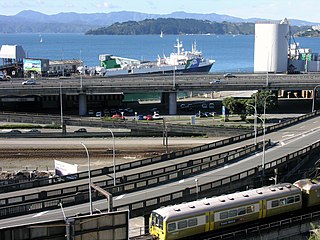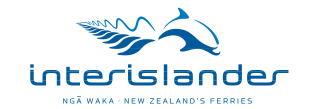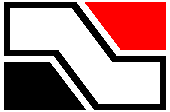See also
- Tranz Am , a 1983 action video game
- Trance (disambiguation)
- Trans (disambiguation)
Tranz is a 2018 song by British virtual band Gorillaz.
Tranz may also refer to:

Transport in New Zealand, with its mountainous topography and a relatively small population mostly located near its long coastline, has always faced many challenges. Before Europeans arrived, Māori either walked or used watercraft on rivers or along the coasts. Later on, European shipping and railways revolutionised the way of transporting goods and people, before being themselves overtaken by road and air, which are nowadays the dominant forms of transport. However, bulk freight still continues to be transported by coastal shipping and by rail transport, and there are attempts to (re)introduce public transport as a major transport mode in the larger population centres.
Metro, short for metropolitan, may refer to:
Tranz Rail, formally Tranz Rail Holdings Limited, was the main rail operator in New Zealand from 1991 until it was purchased by Toll Holdings in 2003.

Rail transport in New Zealand is an integral part of New Zealand's transport network, with a nationwide network of 4,375.5 km (2,718.8 mi) of track linking most major cities in the North and South Islands, connected by inter-island rail and road ferries. Rail transport in New Zealand has a particular focus on bulk freight exports and imports, with 19 million net tonnes moved by rail annually, with 99.5% of New Zealand's exports and imports being transported through the country's seaports.
Tranz Metro was a New Zealand public transport operator. Beginning as the New Zealand Railways Corporation's Cityline division as a result of restructuring in the 1980s, in its final form Tranz Metro was the operator of Metlink's suburban trains owned by the Greater Wellington Regional Council in the Wellington Region of New Zealand.

Interislander is a road and rail ferry service across New Zealand's Cook Strait, between Wellington in the North Island and Picton in the South Island. It is owned and operated by state-owned rail operator KiwiRail. Three roll-on roll-off (RORO) vessels operate the 50-nautical-mile route, taking about three hours to complete the crossing.
New Zealand Railways may refer to KiwiRail which is the current rail services owner/operator and infrastructure owner/maintainer.

The Capital Connection is a long-distance commuter train operated by KiwiRail between Palmerston North and the capital city of Wellington on the North Island Main Trunk. In 2018 the service faced funding issues, but the Government ensured that the service would continue, with the NZTA and regional councils investing in subsidies and the replenishment of rolling stock.

The Coastal Pacific is a long-distance passenger train that runs between Picton and Christchurch in the South Island of New Zealand. It is operated by The Great Journeys of New Zealand division of KiwiRail. It was called the TranzCoastal from May 2000 until temporarily withdrawn in February 2011. It was the first train to use the new AK class carriages.
The Geyserland Express was a long distance passenger train operated by the Tranz Scenic division of Tranz Rail between Auckland and Rotorua in New Zealand's North Island. It utilised the Silver Fern railcars and operated from 9 December 1991 until 7 October 2001.
The Waikato Connection was a short-lived express passenger train between Hamilton and Auckland in New Zealand's North Island. It consisted of a weekday single return service using diesel multiple unit railcars.

New Zealand Railways Corporation (NZRC) is the state-owned enterprise that owns the land beneath KiwiRail's railway network on behalf of the Crown. The Corporation has existed under a number of guises since 1982, when the old New Zealand Railways Department was corporatised followed by deregulation of the land transport sector. In 1986, the Corporation became a State-owned enterprise, required to make a profit. Huge job losses and cutbacks ensued, and the rail network, rail operations and ferry service of the Corporation were transferred to New Zealand Rail Limited in 1990. The Corporation retained ownership of the land beneath the railway network, and charged a nominal rental to New Zealand Rail, which was privatised in 1993, and renamed Tranz Rail in 1995. In 2004, following a deal with Tranz Rail's new owners Toll NZ, the Corporation took over responsibility for maintaining and upgrading the rail network once more, trading under the name ONTRACK. Negotiations with Toll over track access charges concluded after four years with no agreement reached, so the government purchased the entire rail and ferry operations, naming the service KiwiRail. ONTRACK's railway infrastructure and employees were then transferred to KiwiRail in 2008, which itself was initially a subsidiary of the Corporation. On 31 December 2012, the Corporation once again became the landowner.
Transrail may refer to:
KiwiRail Holdings Limited is a New Zealand state-owned enterprise responsible for rail operations in New Zealand, and operates inter-island ferries. Trading as KiwiRail and headquartered in Wellington, New Zealand, KiwiRail is the largest rail transport operator in New Zealand. KiwiRail has business units of KiwiRail Freight, The Great Journeys of New Zealand and Interislander. KiwiRail released a 10-Year Turn-around Plan in 2010 and has received significant government investment in support of this in an effort to make KiwiRail a viable long-term transport operator.

The New Zealand British Rail Mark 2 carriages were built by British Rail Engineering Limited for British Rail in the early 1970s. From the mid-1990s, 150 were exported to New Zealand. After being rebuilt, refurbished and re-gauged, they entered service with a variety of operators on New Zealand's railway network. The carriages generally replaced older NZR 56-foot carriages, some of which had been in use for almost 70 years.

AN Tasrail was an Australian railway operator that operated the Tasmanian rail network from March 1978 until November 2004. Originally a subsidiary of the Federal Government's Australian National, it was sold to Australian Transport Network (ATN) in November 1997. ATN was acquired by Pacific National in 2004 and the AN Tasrail subsidiary was later acquired by the Tasmanian Government in 2009 to become TasRail.
The Tāneatua Branch is a branch railway line from Hawkens Junction to Tāneatua in the Bay of Plenty, New Zealand.

Cato Blue is an informal term describing a New Zealand railway locomotive livery found in common usage amongst the railfan community. The livery was first worn on DFT 7160 as a variation of the New Zealand Rail blue livery. With the introduced of Tranz Rail on 18 October 1995, the livery was adopted to replace New Zealand Rails blue livery, which was introduced in 1991. The scheme was known as Cato Blue after its creator, Cato Partners. DFT 7199 was the first locomotive repainted in the livery after Tranz Rail took over the rail system.
Transdev Wellington is the operator of Wellington's Metlink rail network in New Zealand. The entity is a partnership of Transdev Australasia and Hyundai Rotem, who were awarded the contract to operate and maintain the commuter rail system in December 2015 by the Greater Wellington Regional Council. The contract commenced on 3 July 2016, taking over from KiwiRail division Tranz Metro.

The Great Journeys of New Zealand is the tourism division of KiwiRail that brings together its three Scenic train services with its passenger ferry business, Interislander. The new division was launched in May 2017 and replaced the former tourism brand KiwiRail Scenic Journeys. It has continuity with the earlier InterCity Rail (1987–1995) and Tranz Scenic (1995–2011).